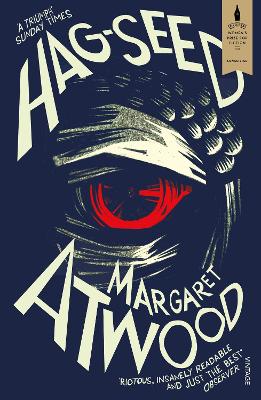Reviewed by brokentune on
Your profanity, thinks Felix, has oft been your whoreson hag-born progenitor of literacy.
When I learned that Margaret Atwood had written a book for the Hogarth Shakespeare series, I was both thrilled and hesitant to pick it up. I love Atwood’s work. I love Shakespeare. However, there are elements of both authors writing that I can see would react like fire and ice.
Atwood is one of my go-to authors for strong female characters. Shakespeare does not come immediately to my mind for that purpose. On the other hand, I love Shakespeare’s thoughtful and often sensitive male characters, which in turn is not something I have really found in an Atwood novel. Most of Atwood’s male characters I’ve encountered were horrid human beings. I mean look at Atwood’s Penelopiad (part of the Canongate Myths Series) to see even the most ancient of heroes being taken down a few pegs. Not that I object – I very much enjoyed her modern deconstruction of the classic story, but I do sometimes feel a little sorry for the male characters that cross her path.
Therefore it is fair to say, I really had some misgivings how Atwood would approach this re-telling of The Tempest, which is packed with men full of ambition, desire, and longings for revenge, and where the only female character, Miranda, is being maneuvered like a chess piece.
I was wrong. Hag-Seed showed that despite their differences, there are also a few things that Shakespeare and Atwood have in common: the ability to come up with a gripping narrative, imaginative ways of explaining the world as they observe it by relating different angles to the unsuspecting reader, a talent for striking a balance between thought-provoking and evocative writing, and best of all an enormous sense of having fun with words.
Readers who may have been put off Shakespeare by having had to sit through endless recitals of famous lines in school may not remember it but Shakespeare was funny. If nothing else, there are memes and objects out there that still thrive on Shakespeare’s appeal to the sense of fun in people. None more so than the Shakespearean insult kit (see here or here for a bit of fun).
Atwood, who can also be wickedly funny, has picked up on this, and actually uses it to lighten up the otherwise potentially depressing or even threatening setting of a prison, where we get to await in anticipation how the inmates will put Shakespeare’s own words to a more creative use. I honestly looked forward to the inmates getting to grips with Shakespeare’s The Tempest by using his own swear words:
“Born to be hanged. A pox o’your throat. Bawling, blasphemous, incharitable dog. Whoreson. Insolent noisemaker. Wide-chapp’d rascal. Malignant thing. Blue-eyed hag. Freckled whelp hag-born. Thou earth. Thou tortoise. Thou poisonous slave, got by the devil himself. As wicked dew as e’er my mother brushed, With raven’s feather from unwholesome fen, Drop on you both. A south-west blow on ye, And blister you all o’er. Toads, beetles, bats light on you. Filth as thou art. Abhorr’ed slave. The red plague rid you. Hag-seed. All the infections that the sun sucks up, From bogs, fens, flats, fall on – add name here – and make him, By inch-meal a disease. Most scurvy monster. Most perfidious and drunken monster. Moon-calf. Pied ninny. Scurvy patch. A murrain on you. The devil take your fingers. The dropsy drown this fool. Demi-devil. Thing of darkness.”
Of course, the investigation into Shakespearean swear words was not the only aspect. I loved. I also loved the scene setting and how Atwood re-imagined the isolation of Prospero’s island in the isolation of the prison, how she transferred the play within the play in The Tempest into a play about a play about a play by making it clear from the outset that Shakespeare’s play The Tempest will be focal point of Felix’s (Atwood’s main character’s) ambition.
I loved how she used the diverse characters to show different interpretations of the original play, and how she transposed issues of colonialism, sexism, privilege, politics, gender issues, and others I haven’t even contemplated yet, from Shakespeare’s work into a modern setting.
So, to anyone, who rolls their eyes at reading Shakespeare because they have been bored to despair with a few lines of his most famous works, I say pick up a copy of Hag-Seed. It is just about one of the most gripping, thoughtful, and entertaining ways to find out why people are still enthralled by his works.
“One question. Is ‘shit’ a curse word? Can we use it, or what?” It’s a fine point, thinks Felix. Technically, “shit” might not be considered a curse word as such, only a scatological expression, but he doesn’t want to hear it all the time. Shit this, shitty that, you shit. He could let them vote on it, but what’s the point of being in charge of this motley assemblage if he refuses to take charge? “‘ Shit’ is off bounds,” he says. “Adjust your cursing accordingly.” “‘ Shit’ was okay last year,” says Leggs. “So how come?” “I changed my mind,” says Felix. “I got tired of it. Too much shit is monotonous, and monotony is anti-Shakespeare.
Reading updates
- Started reading
- 11 December, 2016: Finished reading
- 11 December, 2016: Reviewed
